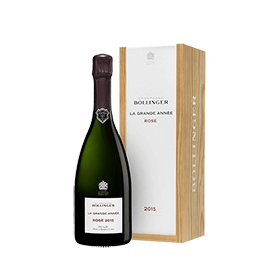Bollinger: an unmissable name among the greatest Champagne houses
Affectionately nicknamed "Bolly," the Bollinger Champagne House oversees a vineyard of 179 hectares of vines, located in the commune of Aÿ in the Marne department. In its constant quest for excellence since its origins in 1829, Bollinger is a refined and particularly delicate expression of the identity and nuances of the great Champagne terroirs. As one of the few estates to use its own grapes for blending, Bollinger oversees a vineyard where 60% of the grapes are Pinot Noir.
An exceptional vineyard in Champagne
Enjoying worldwide renown for their finesse and aromatic richness, the cuvées of the Bollinger Champagne House are made from a vineyard located in the heart of emblematic crus.
With a surface area of 179 hectares, this exceptional terroir is spread across seven main vineyards, 85% of which are Grand and Premier Crus. While the terroirs of Aÿ, Avenay, Tauxières, Louvois and Verzenay (Montagne de Reims) are dedicated to Pinot Noir, that of Cuis (Côte des Blancs) is planted exclusively with Chardonnay and that of Champvoisy (Vallée de la Marne) with Pinot Meunier.
The House of Bollinger also owes its uniqueness to two historic plots of land - Clos Saint-Jacques and Chaudes Terres – which were spared from the phylloxera that decimated the Champagne vineyards at the beginning of the 20th century. Producing the Bollinger Blanc de Noirs champagne Vieilles Vignes Françaises, these two illustrious Aÿ vineyards are subject to rigorous and exclusively manual care, honouring the unique identity of the historic Champagne region.
The refinement and aromatic richness of two rosé champagnes by Bollinger
The Bollinger Champagne House reveals, through two prestigious Rosé cuvées, a gourmet, complex and refined vision of the great Champagne terroirs.
Bollinger Rosé: the quintessence of the Bollinger art of the blend
In 2008, Bollinger produced its first Rosé champagne, with the strong ambition to harmoniously combine freshness, structure and elegance.
Composed of 85% Grand and Premier Crus, this Bollinger Rosé champagne is made from grapes from three plots located in Verzenay (Poirier, Saint-Pierre, Montboeuf). Reflecting Bollinger's constant quest for excellence, these plots are worked by hand with the same rigour as the emblematic plot of La Côte aux Enfants.
The blend of Pinot Noir, Chardonnay and Pinot Meunier is finished with a variable percentage (5 to 6%) of red wine that stems from, according to the vintage, the vineyards of Saint-Pierre, Montboeuf (Verzenay) or Aÿ. This red wine exudes, through its subtle harmony between aromatic power and an exceptional finesse, as much of the mastery of red wine vinification as the art of blending three flagship grapes in Champagne.
With its beautiful golden colour, this Brut champagne has an enticing nose of delicious fruity and spicy fragrances. With a beautiful structure, the mouth has a delightful freshness and smooth feel, and a fruity framework.
An ideal partner for an aperitif or a fruity dessert with little sugar, this Bollinger Brut Rosé should be tasted between 10 and 12°C.
La Grande Année Rosé: the delicate combination of subtlety, freshness and finesse
The second rosé label produced by the house, La Grande Année Rosé is produced from exceptional Champagne crus, namely Aÿ and Verzenay for the Pinot Noir, but also Chouilly, Oiry, Le Mesnil-sur-Oger, Cramant and Oger for the Chardonnay.
This subtle blend is completed, depending on the vintage, by a percentage of red wine from vineyards located on the Côte aux Enfants.
Vinified in barrels and benefitting from an ageing period in the cellar that is twice as long as the rules laid down in the appellation's specifications, La Grande Année Rosé reveals, across the vintages, the finesse and expression of these great vineyards.
A delicate colour precedes a complex nose, finely blending a beautiful fruity structure with delicious notes of blond tobacco and dried flowers.
Structure, freshness and delicacy are the terms that best define the palate, which has a creamy feel and richness that draw out to a lively, fruity finish.
Served between 8 and 10°C, this vintage Rosé Champagne pairs perfectly with fish (red tuna tataki), shellfish (blue lobster) or fine meats such as duck breast, quail, venison in grand veneur sauce or pigeon. Exotic and oriental cuisine can also be served with this exceptional rosé champagne, as well as desserts (rhubarb and red fruit crumble).



